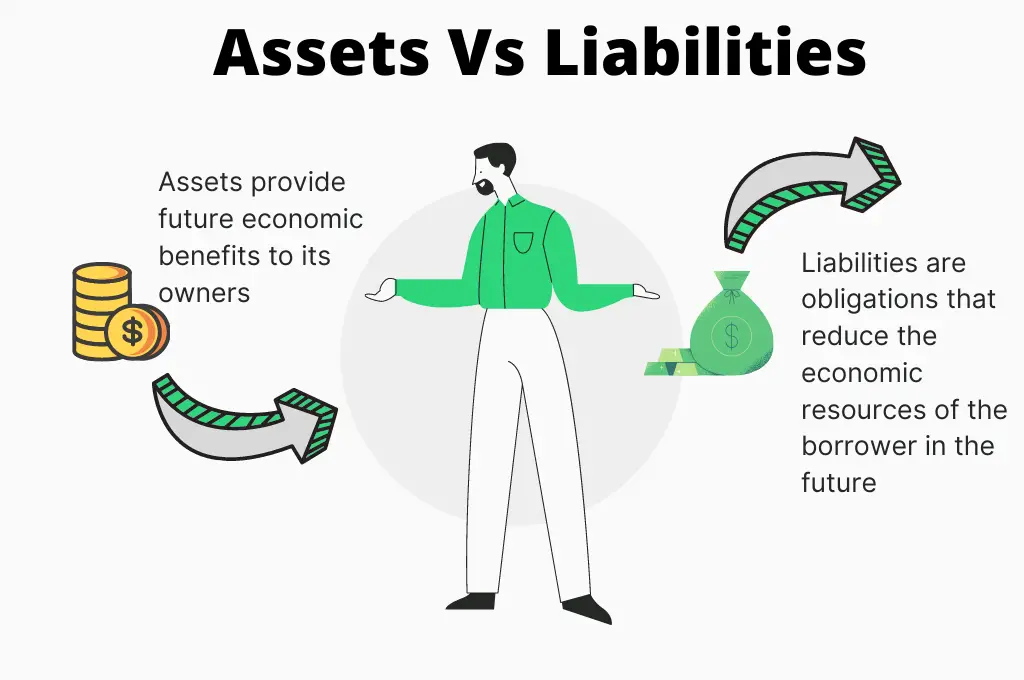
Knowing how to differentiate between assets and liabilities is fundamental in understanding the accounting equation.
The distinction between the two elements of financial statements can be confusing to beginners because transactions that affect the liabilities often also affect the assets.
Assets Vs. Liabilities
Assets bring future economic benefits to its owners, whereas liabilities are the obligations for future payments. Therefore, the distinction between assets or liabilities depends on whether something will result in the inflow or outflow of economic benefits in the future.
Assets result in the inflow of valuable resources to its owners or users, whereas liabilities cause an outflow of valuable resources from the borrower.
You can think of assets as something that enables a business to create wealth in the future.
For example:
- Cash helps a business to pay for expenses that are necessary to earn an income.
- A machine helps to manufacture products that a business can sell in the future.
- Inventory can be sold to customers to earn revenue in the future.
All of the above assets provide economic benefits to the owners or users.
In contrast, liabilities are the obligations to deliver something valuable to another person or business, such as cash, inventory, or service in the future.
For example, if a business buys goods on credit from its supplier, it has a legal obligation to pay the supplier cash in the future.

Even though assets and liabilities appear to have very little in common,
it is quite usual for the same business transactions to affect both assets and liabilities. This is because debt is one of the two sources of funding the business assets, the other source being equity.
In the accounting books, assets are debit balances and appear on the balance sheet’s left side. On the other hand, Liabilities are credit balances and are shown on the right side of the balance sheet alongside equity.
According to the accounting equation, the total assets that a business owns minus its total liabilities must always equal the amount of equity.
The following example illustrates how assets and liabilities interact in business transactions and how you can distinguish between them for the correct accounting treatment.
Example

Jack borrows $5000 cash from his friend Jimmy to invest in a car rental business.
The $5000 cash is an asset for Jack that he can use to start his business. He now also has a liability of the same amount that is owed to his friend.
To record the loan’s receipt in his books, Jack must increase both his assets (cash in hand) and liabilities (loan from Jimmy) by the same amount.
Debit Cash in hand $5000
Credit Loan from Jimmy $5000
Jack got a good bargain on a used car and was able to purchase it for $4,000.
The transaction does not affect Jack’s liability account because one asset (cash in hand) has been exchanged for another asset (motor vehicle) which should be recorded as follows.
Debit Motor Vehicle $4000
Credit Cash in hand $4000
One month later, Jack returned the full amount of the loan by paying in cash.
Paying off the amount of loan will reduce the value of assets invested in Jack’s business. He should, therefore, reduce both the liability account and the cash in hand account.
Debit Loan from Jimmy $5000
Credit Cash in hand $5000
Instructions for solving quiz:
- Click on one of the given options that you think is correct.
- If you are not sure about a question, review the lesson above.
- Mark yourself out of 5 by rewarding 1 mark for each correct answer.
Good luck!
Question 1
__________ is the amount that you owe to someone.
Asset
Incorrect.
Liability
You're right!
Question 2
Assets of a business can increase by incurring a liability.
True
Correct!
An example of this is the receipt of a bank loan. The amount received from the bank is an asset of the borrower from the moment it is able to use it.
False
Wrong answer.
Question 3
Which of the following are shown on the balance sheet?
Assets
Wrong answer.
Liabilities
Wrong answer.
Both
You're right!
Assets are shown on the left side of the balance sheet and liabilities appear on the right side.
Question 4
Which of the following are assets or liabilities for a bank?
a) A business loan issued to a client.
Asset
Correct!
From the perspective of the bank, the loan issued to a client is an asset because it entitles it to receive interest and principal (economic benefit) in the future.
Liability
Incorrect.
b) The available balance of a customer’s current account held at the bank.
Asset
Incorrect.
Liability
You're right!
The account balance is no doubt an asset of the client.
However, from the perspective of the bank it is a liability because it represents the money that the bank owes to its client upon his or her request.
How many questions did you answer correctly?
Score Grade
5 Master
4 Pro
3 Pass
